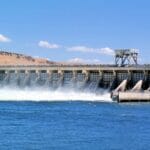If you’re curious about hydroelectric energy and want to learn more about this renewable power source, you’re in the right place. In this article, we’ll delve into 10 fascinating facts about hydroelectric energy, exploring its inner workings, benefits, and potential drawbacks. So, whether you’re wondering how hydropower works, the advantages of hydroelectric energy, or simply want to discover what makes it such a significant player in the renewable energy landscape, join us as we uncover the ins and outs of hydroelectric power.
Key Takeaways:
- Water is a plentiful, free, and renewable resource used to generate electricity through hydroelectric power.
- Hydroelectric power does not produce any carbon dioxide emissions.
- Electricity can be generated 24 hours a day as long as there is enough water.
- The United States has over 2,000 hydroelectric power plants.
- Norway and Brazil rely on hydropower for up to 85% of their electricity needs.
- The Three Gorges Dam in China is the world’s largest dam and hydroelectric power plant.
- Hydroelectricity is cost-effective and considered one of the cleanest sources of energy.
- Hydroelectric power is more efficient than fossil fuel.
- The Niagara Falls dam was the first dam built in America, marking a milestone in hydroelectric energy.
- Some dams provide fish ladders and elevators to assist in fish migration.
10 Facts About Hydroelectric Energy

Hydroelectric energy, derived from the power of flowing water, offers a wealth of benefits as a renewable and clean source of electricity. Let’s delve into 10 compelling facts that highlight the significance of hydroelectric power in our quest for a greener future.
1. Plentiful and Renewable
Water, the primary resource used in hydroelectric power generation, is a mighty force that is abundantly available. Unlike other fossil fuels, water is a renewable resource, making hydroelectric energy an environmentally sustainable choice.
2. Carbon Emission-Free
When water is harnessed to generate electricity, hydroelectric power produces zero carbon dioxide emissions. This makes it a crucial player in reducing greenhouse gas emissions and combating global climate change.
3. 24/7 Power Supply
One of the most remarkable aspects of hydroelectric energy is its ability to function round the clock. As long as there is a sufficient water source, electricity can be generated continuously, providing a reliable power supply for both residential and industrial needs.
4. A Global Presence
The United States alone boasts more than 2,000 hydroelectric power plants, underlining the widespread adoption of this technology in the pursuit of cleaner energy sources. Countries like Norway and Brazil also heavily rely on hydroelectric power, with up to 85% of their electricity being generated from this renewable source.
5. Scale of the Three Gorges Dam
The Three Gorges Dam in China takes the crown as the world’s largest dam and hydroelectric power plant. This colossal structure serves as a testament to the immense capacity of hydroelectric power and its capability to meet the demands of a rapidly growing population.
6. Cost-Effective and Efficient
Utilizing the power of water, hydropower proves to be a cost-effective energy solution. Due to its exceptional efficiency, hydroelectric power outperforms traditional fossil fuels when it comes to converting energy into electricity. This makes it an economically viable option for meeting our energy needs.
7. Milestone: The Niagara Falls Dam
The Niagara Falls dam takes pride in being the pioneering hydroelectric power plant in the United States. Its construction marked a significant milestone in the history of hydroelectric energy, showcasing the potential of harnessing nature’s power to generate clean and renewable electricity at a large scale.
8. Fish Migration Assistance
Not all dams are created equal. Some incorporate innovative features such as fish ladders and elevators that aid in fish migration. This thoughtful design allows fish to navigate around the dams, safeguarding their natural habitats and ensuring ecological balance.
9. Varied Sustainable Applications
Hydroelectric power demonstrates its flexibility by catering to diverse energy needs. It can power small rural communities, supply electricity to urban areas, support irrigation systems, and even provide energy for industrial operations. Its adaptability contributes to sustainable development across various sectors.
10. A Clean Energy Champion
Hydroelectric energy stands tall as one of the cleanest energy sources available to us. With its environmental advantages, carbon-neutral operation, and potential to meet the growing power demands of our world, it serves as a beacon of hope for a greener and more sustainable future.
Hydroelectric energy, with its abundance, eco-friendliness, and versatility, holds immense promise as a leading player in the transition towards a clean energy future. By embracing the power of flowing water, we take a significant step towards preserving our planet and securing a better tomorrow.
Here are 10 fascinating facts about hydroelectric power that will leave you amazed! Did you know that hydroelectric power generates sustainable electricity by harnessing the power of flowing water? Discover more intriguing facts about hydroelectric power here.
Did you know that hydroelectricity is the largest source of renewable energy globally? Dive into the world of hydroelectricity and explore more interesting facts here.
Looking for some mind-blowing facts about hydropower? Look no further! Uncover fascinating details about hydropower and its impact on clean energy production here.
Hydropower Pros and Cons

Pros of Hydropower
Renewable and Low Emissions: Hydropower is a sustainable energy source as long as there is a continuous flow of water. This renewable nature makes it an environmentally friendly alternative to fossil fuel-based power generation. It also emits significantly fewer greenhouse gases, contributing to lower carbon emissions.
Reliable and Stable: Hydropower provides a consistent and reliable supply of electricity as long as there is sufficient water available. This stability makes it an ideal choice for baseload power generation, ensuring a constant flow of electricity to meet energy demands.
Flood Control and Water Management: Hydropower dams can effectively manage flood control by storing excess water during periods of heavy rainfall and gradually releasing it as needed. These dams also contribute to efficient water management by storing water during times of abundance and releasing it during periods of drought.
Water Supply: In addition to generating electricity, hydropower facilities can serve as a dependable source of water for irrigation, drinking, and other essential purposes. This dual functionality makes them valuable assets in regions where water scarcity is a concern.
Cons of Hydropower
Environmental Impacts: The construction of dams and reservoirs for hydropower generation can have significant environmental consequences. This process often leads to habitat destruction, altering natural water flow, and negatively impacting ecosystems. It is crucial to carefully assess and mitigate these environmental impacts during project planning and implementation.
Loss of Biodiversity: The creation of reservoirs through hydropower projects can result in the loss of biodiversity. The submerging of large land areas disrupts ecosystems, displacing plant and animal species. Preserving biodiversity should be a key consideration when developing hydropower infrastructure.
Displacement of Communities: The construction of dams and reservoirs may require the relocation of communities living in the project’s vicinity. Such displacements can lead to the loss of livelihoods, cultural heritage, and social disruptions. Ensuring proper compensation and resettlement measures is essential to mitigate the negative impacts on affected communities.
Methane Emissions: While hydropower is generally a low-emission energy source, some reservoirs may release methane, a potent greenhouse gas, due to the decomposition of organic matter in submerged vegetation. Careful monitoring and management of reservoirs can help mitigate these methane emissions.
High Upfront Costs and Long Lead Times: Building hydropower infrastructure requires significant upfront investment and long lead times for planning and construction. The costs associated with dam construction, land acquisition, and environmental impact assessments can be considerable. Additionally, the lengthy planning and approval processes can further delay project implementation.
Key Takeaways:
- Hydropower is a renewable energy source with low greenhouse gas emissions, making it an environmentally friendly choice for electricity generation.
- It provides a reliable and stable supply of electricity, making it suitable for baseload power generation.
- Hydropower dams offer flood control and efficient water management capabilities, contributing to water sustainability.
- However, issues such as environmental impacts, loss of biodiversity, community displacement, methane emissions, and high upfront costs should be carefully considered when implementing hydropower projects.
Sources:
1. EnergySage: The Top Pros And Cons of Hydropower
2. Britannica: Hydroelectric power | Definition, Renewability
Advantages Of Hydroelectric Energy
Hydroelectric energy offers a range of advantages that make it a key player in the transition to a sustainable and greener future. From flexible energy generation to economic growth, hydroelectric power provides numerous benefits for our environment and society. Let’s explore the advantages of hydroelectric energy:
1. Flexible Energy Generation and Storage
One major advantage of hydroelectric power plants is their ability to adjust electricity output based on changing demand. This flexibility ensures a stable and reliable energy source that can meet the needs of homes, businesses, and industries. Additionally, these power plants can store excess energy by diverting water into reservoirs during periods of low demand. This stored energy can be released when demand is high, providing a consistent and efficient source of electricity.
2. Reducing Dependence on Fossil Fuels
Hydropower reduces our reliance on fossil fuels, such as coal and natural gas, which are major contributors to greenhouse gas emissions. By harnessing the power of flowing water, hydroelectric energy promotes energy independence and decreases carbon dioxide emissions. This shift towards renewable energy sources is crucial in mitigating the impacts of climate change and reducing air pollution.
3. Flood Protection
Hydroelectric dams and reservoirs play a crucial role in regulating water flow and mitigating the risk of flooding in downstream areas. By controlling the release of water, these structures help manage river levels during periods of heavy rainfall or snowmelt, protecting communities and infrastructure from devastating floods. This flood protection is essential for safeguarding lives and properties in vulnerable regions.
4. Water Supply for Domestic and Commercial Use
In addition to generating electricity, hydropower facilities provide a reliable water supply for both residential and commercial purposes. These plants harness the power of flowing water while ensuring a continuous and sufficient water supply for drinking, irrigation, industrial processes, and other essential needs. The accessibility of clean water from hydropower plays a vital role in supporting human health, sanitation, and economic activities.
5. Opportunities for Employment, Education, and Recreation
The construction and operation of hydroelectric plants create employment opportunities, stimulate economic growth, and support local communities. Job creation ranges from engineering and construction to ongoing operations and maintenance. Furthermore, hydroelectric projects often provide educational and training programs, equipping individuals with the skills needed for the renewable energy sector. Additionally, these facilities offer recreational opportunities such as boating and fishing, enhancing the quality of life for nearby communities.
6. Inexpensive and Clean Energy
Hydropower is known for offering cost-effective electricity generation. Compared to fossil fuel power plants, hydropower facilities have lower operating costs and don’t require expensive fuel sources. This cost efficiency translates into affordable electricity prices for consumers, contributing to energy accessibility and affordability. Additionally, hydroelectric energy is clean, producing minimal emissions during electricity generation. The absence of greenhouse gas emissions and air pollutants makes it an environmentally friendly energy source.
7. Irrigation Support
Hydroelectric facilities can support irrigation systems by providing a reliable water supply for agricultural purposes. Water stored in reservoirs can be released to irrigate crops, enhancing agricultural productivity and improving food security. This irrigation support plays a crucial role in enhancing crop yield and ensuring sustainable agricultural practices, further contributing to economic development and food production.
8. Boosting Economic Growth
The development of hydroelectric projects stimulates economic growth by attracting investments, creating business opportunities, and driving infrastructure development. These projects require significant financial investments and foster job creation, providing a positive impact on local and regional economies. Additionally, the availability of reliable and affordable electricity from hydropower attracts industries, supports manufacturing, and drives economic diversification.
Key Takeaways:
- Hydroelectric energy offers flexible energy generation and storage, allowing for adjusted electricity output and storing excess energy during periods of low demand.
- It reduces dependence on fossil fuels, contributing to energy independence and decreasing greenhouse gas emissions.
- Hydroelectric dams and reservoirs provide flood protection by regulating water flow and mitigating the risk of downstream flooding.
- Hydropower facilities supply water for domestic and commercial use, ensuring a reliable water source for various purposes.
- The construction and operation of hydroelectric plants create job opportunities, stimulate economic growth, and provide recreational benefits.
- Hydropower is cost-effective and provides clean energy, without the emissions associated with fossil fuel power plants.
- It supports irrigation systems, aiding agricultural practices and improving crop yield.
- The development of hydroelectric projects stimulates economic growth, attracting investments and creating business opportunities.
FAQ
Q1: What is hydroelectric energy?
A1: Hydroelectric energy, also known as hydropower, is a renewable energy source that harnesses the power of flowing or falling water to generate electricity. It involves the use of turbines and dams to convert the kinetic energy of water into electrical energy.
Q2: How does hydropower work?
A2: Hydropower works by utilizing the energy of moving water to generate electricity. It typically involves the construction of dams to create reservoirs, which store water. When released, the water flows through turbines, causing them to spin. The spinning turbines then activate generators, producing electricity.
Q3: What are the pros and cons of hydropower?
A3: The pros of hydropower include its renewability, low emissions, reliability, flood control capabilities, and provision of a water supply for various purposes. However, hydropower also has cons such as environmental impacts, loss of biodiversity, displacement of communities, potential methane emissions, and high upfront costs.
Q4: What are the advantages of hydroelectric energy?
A4: Hydroelectric energy offers several advantages, including its flexibility in energy generation and storage, reduction in fossil fuel dependence and greenhouse gas emissions, flood protection, water supply provision, job creation, affordability, support for irrigation, and contribution to economic growth.
Q5: How does hydroelectric energy benefit the environment?
A5: Hydroelectric energy benefits the environment by being a clean and renewable energy source with minimal greenhouse gas emissions. It also helps regulate water flow, protect against floods, support ecosystems through proper reservoir management, and reduce reliance on fossil fuels, which contribute to climate change.
- Sept 31 Myth: Unveiling Calendar Secrets - March 18, 2025
- How Long & Till December 18, 2025: Accurate Countdown Guide - March 18, 2025
- Discover Japanese Artists: A Complete History - March 18, 2025
















